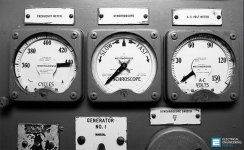Overengineering 101. The NTC does a good job in all circumstances. Probably too simple and too effective 🙂
NTC's are about as simple as it gets...aside from NTC's i also stick in an MOV across the power traffo primary...
MOV ?? What is it? 😱
mov electronics - Google Search
MOV electronics
A varistor is an electronic component with an electrical resistance that varies with the applied voltage. Also known as a voltage-dependent resistor (VDR), it has a nonlinear, non-ohmic current–voltage characteristic that is similar to that of a diode. ... This type is commonly known as the metal-oxide varistor (MOV).
Varistor - Wikipedia).
Then it might be a nice idea to have the sequencer switch the mains at a voltage peak, both switch-on and switch-off.
You’ll probably want to cover brownout and mains cable disconnect/reconnect like an intermittent mains outage.
Common knowledge on dutch technical schools decades ago. Anyone reading Elektuur/Elektor knew this too.
It seems today some people search for complicated ways to solve non-issues already solved a long time ago. Or, worse, to find a new way of doing things that is way worse than the old method. On this forum one can detect some design errors in designs that are accepted and defended.
Nah, quality and efficiency are boring 🙂
It seems today some people search for complicated ways to solve non-issues already solved a long time ago. Or, worse, to find a new way of doing things that is way worse than the old method. On this forum one can detect some design errors in designs that are accepted and defended.
Nah, quality and efficiency are boring 🙂
Last edited:
Oh I am OK but I am disappointed in new developments that run backwards and basic technical stuff being forgotten.
Last edited:
when using a simple toggle switch how is one to know that you are not switching at the zero crossing?
Not. It is a matter of statistics. How high is the chance that one switches at exactly the zero crossing? And what if one does once in a year?
In case of the "SSR with zero crossing switching" ask the same questions 🙂
In case of the "SSR with zero crossing switching" ask the same questions 🙂
Last edited:
That is THE modus operandi of mechanical switches. Just suppose you have to switch exactly at zero crossing or otherwise things go wrong 😀 A bit like syncing was done by hand in the old days with generators. Sweat in the hands.
Attachments
Last edited:
A zero xing SSR does NOT switch on at the zero crossing. It ignites the triac at the zero crossing. That triac takes several msecs to get all fired up, so to say, which places the mains switching point almost smack on the top of the sine wave.
When I started working on the sequencer, with a small microcontroller, I'd switch the triac a couple of msec before the zero xing to neatly switch the load transformer at exact zero crossing. I couldn't understand why those fuses popped, until I discovered that at zero crossing the dV/dT is max and the xformer looks almost like a short.
And so you learn what the professionals learned decades before you!
Jan
When I started working on the sequencer, with a small microcontroller, I'd switch the triac a couple of msec before the zero xing to neatly switch the load transformer at exact zero crossing. I couldn't understand why those fuses popped, until I discovered that at zero crossing the dV/dT is max and the xformer looks almost like a short.
And so you learn what the professionals learned decades before you!
Jan
- Home
- Amplifiers
- Tubes / Valves
- Tube amp high-voltage delay
